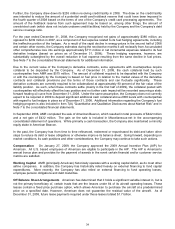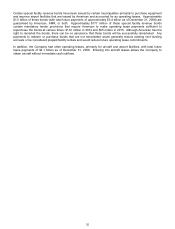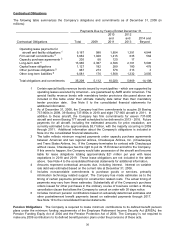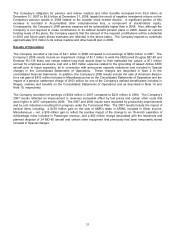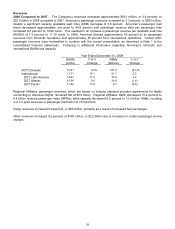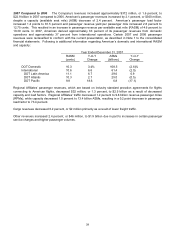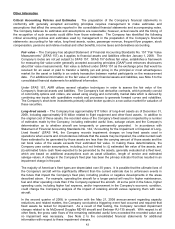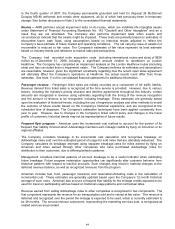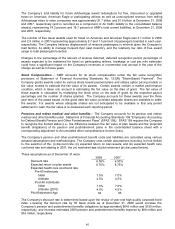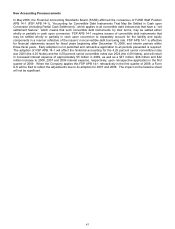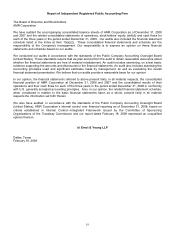American Airlines 2008 Annual Report Download - page 46
Download and view the complete annual report
Please find page 46 of the 2008 American Airlines annual report below. You can navigate through the pages in the report by either clicking on the pages listed below, or by using the keyword search tool below to find specific information within the annual report.
43
Other Information
Critical Accounting Policies and Estimates The preparation of the Company’s financial statements in
conformity with generally accepted accounting principles requires management to make estimates and
assumptions that affect the amounts reported in the consolidated financial statements and accompanying notes.
The Company believes its estimates and assumptions are reasonable; however, actual results and the timing of
the recognition of such amounts could differ from those estimates. The Company has identified the following
critical accounting policies and estimates used by management in the preparation of the Company’s financial
statements: accounting for fair value, long-lived assets, routes, passenger revenue, frequent flyer program, stock
compensation, pensions and retiree medical and other benefits, income taxes and derivatives accounting.
Fair value – The Company has adopted Statement of Financial Accounting Standards No. 157 “Fair Value
Measurements” (SFAS 157) as it applies to financial assets and liabilities effective January 1, 2008. The
Company’s routes are not yet subject to SFAS 157. SFAS 157 defines fair value, establishes a framework
for measuring fair value under generally accepted accounting principles (GAAP) and enhances disclosures
about fair value measurements. Fair value is defined under SFAS 157 as the exchange price that would be
received for an asset or paid to transfer a liability (an exit price) in the principal or most advantageous
market for the asset or liability in an orderly transaction between market participants on the measurement
date. For additional information on the fair value of certain financial assets and liabilities, see Note 3 to the
consolidated financial statements for additional information.
Under SFAS 157, AMR utilizes several valuation techniques in order to assess the fair value of the
Company’s financial assets and liabilities. The Company’s fuel derivative contracts, which primarily consist
of commodity options and collars, are valued using energy and commodity market data which is derived by
combining raw inputs with quantitative models and processes to generate forward curves and volatilities.
The Company’s short-term investments primarily utilize broker quotes in a non-active market for valuation of
these securities.
Long-lived assets – The Company has approximately $17 billion of long-lived assets as of December 31,
2008, including approximately $16 billion related to flight equipment and other fixed assets. In addition to
the original cost of these assets, the recorded value of the Company’s fixed assets is impacted by a number
of estimates made by the Company, including estimated useful lives, salvage values and the Company’s
determination as to whether aircraft are temporarily or permanently grounded. In accordance with
Statement of Financial Accounting Standards No. 144, “Accounting for the Impairment or Disposal of Long-
Lived Assets” (SFAS 144), the Company records impairment charges on long-lived assets used in
operations when events and circumstances indicate that the assets may be impaired, the undiscounted cash
flows estimated to be generated by those assets are less than the carrying amount of those assets and the
net book value of the assets exceeds their estimated fair value. In making these determinations, the
Company uses certain assumptions, including, but not limited to: (i) estimated fair value of the assets; and
(ii) estimated future cash flows expected to be generated by the assets, generally evaluated at a fleet level,
which are based on additional assumptions such as asset utilization, length of service and estimated
salvage values. A change in the Company's fleet plan has been the primary indicator that has resulted in an
impairment charge in the past.
The majority of American’s fleet types are depreciated over 30 years. It is possible that the ultimate lives of
the Company’s aircraft will be significantly different than the current estimate due to unforeseen events in
the future that impact the Company’s fleet plan, including positive or negative developments in the areas
described above. For example, operating the aircraft for a longer period will result in higher maintenance,
fuel and other operating costs than if the Company replaced the aircraft. At some point in the future, higher
operating costs, including higher fuel expense, and/or improvement in the Company’s economic condition,
could change the Company’s analysis of the impact of retaining aircraft versus replacing them with new
aircraft.
In the second quarter of 2008, in connection with the May 21, 2008 announcement regarding capacity
reductions and related matters, the Company concluded a triggering event had occurred and required that
fixed assets be tested for impairment. As a result of that testing, the Company recorded impairment
charges related to its McDonnell Douglas MD-80 aircraft and Embraer RJ-135 aircraft. With respect to all
other fleets, the gross cash flows of the remaining estimated useful lives exceeded the recorded value and
no impairment was necessary. See Note 2 to the consolidated financial statements for additional
information with respect to these impairment charges.



